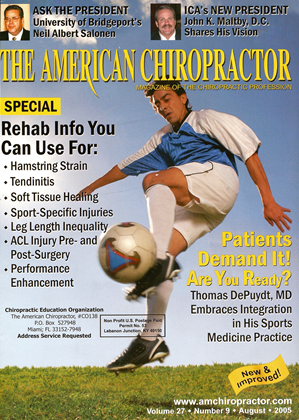LOW BACK PAIN AFFECTS ALMOST everyone during their lifetime, and this includes well-conditioned athletes. The very nature of athletics is that the athlete is performing an activity that requires a high level of skill, strength, power and/or coordination. Most athletic activities impart very high short-duration repetitive forces into various parts of the body, while other areas are subjected to less force, but for prolonged periods. The former leads to macrotrauma, while the latter leads to microtrauma. In either case, when tissue tolerance is exceeded, tissue failure and breakdown occurs leading to injury.1 In tennis, for example, the shoulder is required to move through extreme ranges while the shoulder muscles arc generating tremendous torque, i.e., the overhead serve. Meanwhile, some of the shoulder muscles function to maintain the head of the humerus in a very spe- cific location against the glenoid, while the trunk/spinal muscles stabilize the trunk/spine to provide a stable base of support to the shoulder complex. Most often, shoulder pain results from the rcpetitiveness of the motions rather than one single event (repetitive microtrau-ma). The prime movers of the shoulder adapt and become stronger, while the stabilizers (most often the infraspinatus) arc eventually over-powered and fail in their attempt to maintain optimum joint position, referred to as movement in the neutral zone. Research has linked exces- sivc neutral zone motion to pain production.2 The tissue damage that occurs from tissue failure produces an immediate neurological reflex inhibition to the muscles acting across the injured joint.3-4 This leads to muscle weakness and atrophy, which predisposes thejoint to further injury.5 This inhibition and muscle weakening can occur across any joint in the body that sustains an injury, including the lower back joints. Current research has shown that the small stabilization muscles of the lower lumbar spine atrophy and weaken following tissue failure in the area.6 This, then, reduces the stability of the segment affected by the specific muscle weakness leading to instability. Panjabi defines clinical instability as occurring when the stabilizing system cannot maintain the intervcrtcbral neutral zone in physiological limits.7 In an attempt to compensate for the weakened tissues of the injured lumbar segment, the body will resort to activating the large global muscles of the back. This has the effect of "stiffening" the spine and reduces movement in the whole lumbar spine.7-* Every chiropractor has, at one time or another, witnessed the patient with debilitating lumbar muscle spasm and extremely reduced motion. Highly conditioned athletes often incur forces into their lower back that lead to tissue failure and this cycle of inhibition, weakness and instability. Roy found local muscle dysfunction in elite athletes despite rigorous general training regimens.9 "Injury to a joint or its associated passive stmctures will have direct effects upon muscle function and control and needs to be understood, if rehabilitation programs arc to be efficient and effective."10 Rehabilitation of the athlete with low back pain must address the motion (vertebral movement and position) and motor (muscle) changes that take place when there has been tissue damage, whatever the tissue might be." The chiropractic physician trained in spinal manipulative therapy and rehabilitation procedures can usually help athletes recover from their injuries without the need for medication, injections, or surgery and their potential adverse side-affects. Research demonstrated an immediate increase in muscle strength following spinal manipulative therapy performed via mechanical force, i.e, manually assisted instrument adjusting, following the Activator Methods protocol.12 I have no doubt that similar strength increases occur with other methods of spinal adjusting. This appears to be the result of reducing the inhibition to the inhibited muscles by altering the proprioceptive input from the tissues in the area of the injury. Spinal adjusting to correct the motion problem and specific rehabilitation procedures to correct the motor changes are vital for the return of the athlete to optimum performance.! See references on pg. 62 Dr. Guclgel has been a practicing chiropractor ami physical therapist for 30 years ami recently joined the Aclivator Health Center in Phoenix, Arizona, as Director of Rehabilitation Services. He was a contributing editor to the Activator Methods Chiropractic Technique textbook. He has been an Activator Methods instructor for more than 22 years.
 View Full Issue
View Full Issue






